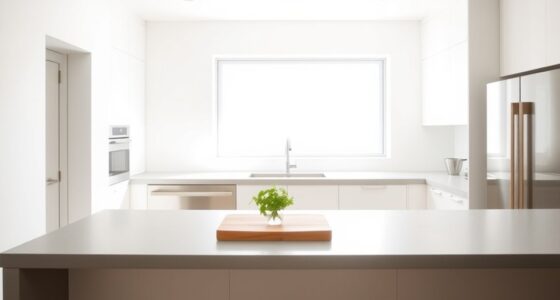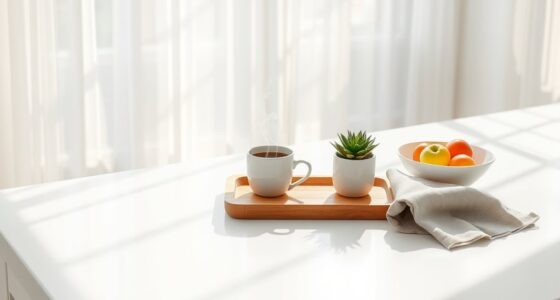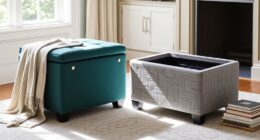Minimalists never have messy closets because you focus on intentionality with your possessions. By keeping only what you truly need and cherish, your items serve a clear purpose and are easy to access. Designating specific spots for each object makes tidying effortless. This mindset reduces clutter and the anxiety that comes with it, creating a calm environment. Discover how adopting minimalism can transform not just your closet, but your entire living space.
Key Takeaways
- Minimalists maintain fewer possessions, making it easier to keep closets organized and clutter-free.
- Intentional curation of belongings ensures only significant items are kept, reducing overall clutter.
- Designating specific places for each item facilitates quick tidying and easy access.
- Regular decluttering and a one-in, one-out policy help maintain closet organization over time.
- Emphasizing emotional connections to cherished items promotes mindful consumption and reduces clutter accumulation.
The Connection Between Minimalism and Organization
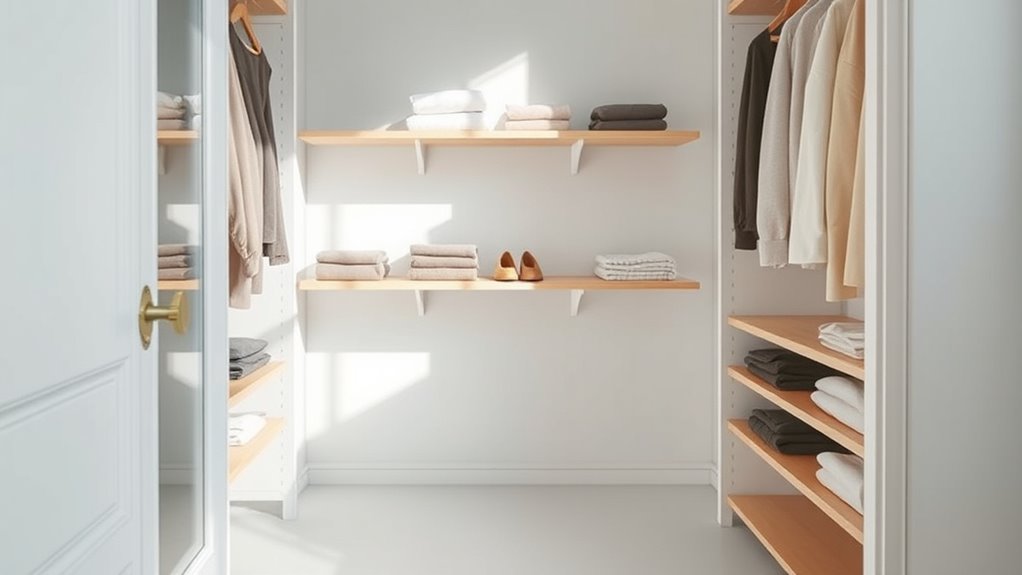
When you embrace minimalism, you often find that organization becomes simpler and more intuitive. With fewer possessions, your closets transform into clutter-free spaces that are easy to manage.
By intentionally curating your belongings, every item you keep holds significance, making it easier to maintain an organized environment. Minimalism encourages you to designate specific places for each item, allowing for quick tidying and efficient storage solutions.
You'll find that decluttering strategies, like starting with less visible areas, help you maintain organization throughout your entire living space. The focus on intentionality in minimalism greatly reduces the accumulation of unnecessary items, leading to clearer, more functional closets. Additionally, mindful decluttering strategies promote a sustainable approach to organization, ensuring your space remains clutter-free in the long term.
Embracing this lifestyle can turn chaos into calm, making your daily routine smoother.
Understanding Messy Minimalism

Understanding messy minimalism means embracing your imperfect spaces while being intentional about what you keep. It's about balancing your possessions with functionality, so your home reflects your unique style and needs. Engaging in mindfulness practices can enhance awareness and help you appreciate the beauty in simplicity.
Embracing Imperfect Spaces
Embracing imperfect spaces allows you to create a home that feels authentic and lived-in, rather than a sterile showcase of minimalism.
Messy minimalism recognizes that perfection is unattainable, encouraging you to maintain a balance between functionality and a bit of messiness. By focusing on keeping everything organized, you can designate specific places for your cherished items, making it easier to manage clutter and maintain your living areas.
This approach fosters a forgiving view of your environment, alleviating feelings of shame associated with mess. Remember, living with less doesn't mean sacrificing joy or personality; it's about surrounding yourself with meaningful possessions that truly reflect your values and lifestyle. Embrace the beauty of imperfection in your home. Integrating natural materials into your decor can enhance the authenticity of your space.
Intentional Decluttering Practices
Creating a home that reflects your values involves more than just accepting imperfections; it requires intentional decluttering practices that prioritize what truly matters.
Start by focusing on less visible areas like your closets. This helps you tackle hidden clutter and creates an organized space.
Embrace a Messy Minimalism mindset, where you accept imperfections but still designate specific places for your belongings. This approach makes tidying up quicker and easier.
With intentionality at the forefront, you'll develop a deeper emotional connection to the items you keep, ensuring they're genuinely valued and functional.
Regularly engaging in intentional decluttering practices will help maintain your closet organization, preventing that overwhelming messiness from creeping back in over time. Additionally, adopting the four-box method can streamline your decluttering process by effectively categorizing your belongings.
Balancing Possessions and Functionality
While many believe that minimalism means living in an austere, perfectly tidy environment, messy minimalism shows that you can balance possessions with functionality. By designating specific places for your belongings, you can embrace a bit of messiness while keeping your space functional.
Consider these aspects:
- Fewer items lead to easier organization.
- Intentional decisions reduce clutter accumulation.
- Designated spots enhance accessibility.
- Targeting overlooked areas, like storage units, improves overall functionality.
- This approach can be particularly effective for those who are also exploring DIY tiny house construction, as it encourages thoughtful organization in smaller spaces.
This approach not only makes tidying quicker but also cultivates a peaceful environment.
The Impact of Intentionality on Clutter
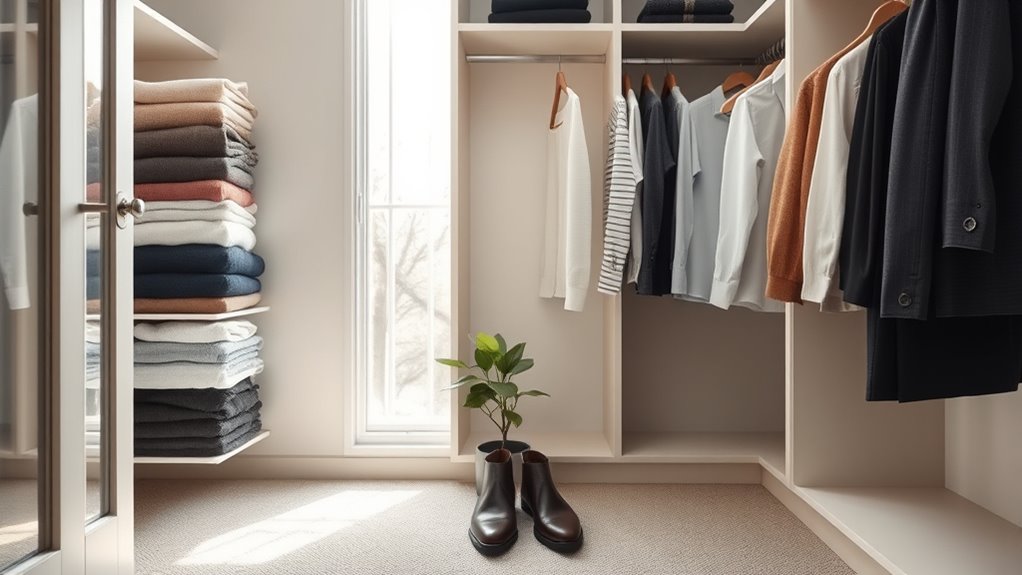
Intentionality plays an essential role in how you manage clutter, shaping your decisions about what to keep and what to let go. By focusing on emotional connections to your items, you can make thoughtful choices that prevent unnecessary accumulation.
Minimalists surround themselves with only cherished possessions, achieving an organized closet that reflects their intentional mindset. This approach emphasizes functionality and ease of access, making it easier to maintain tidy spaces.
When you declutter with purpose, you reinforce the importance of intentional decisions, ensuring every item serves a meaningful role in your life. Ultimately, this practice leads to clearer thinking and a more manageable environment, allowing you to enjoy a clutter-free lifestyle without the stress of disorganization.
How Minimalism Reduces Stress and Enhances Focus
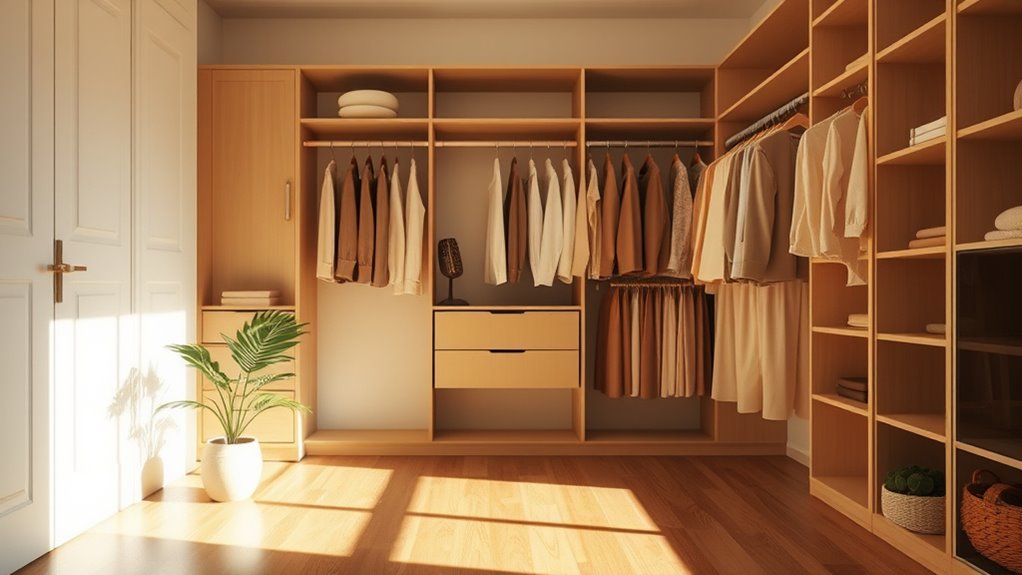
Here are some benefits of minimalism:
- Less clutter leads to a calmer atmosphere.
- Designated spaces for your belongings make tidying up quicker and easier.
- Prioritizing what matters helps you focus on essential tasks without distractions.
- Mindfulness grows as you surround yourself only with cherished items.
This intentional approach alleviates feelings of shame that often come with messiness and greatly reduces anxiety related to disorganization. Furthermore, embracing minimalism can enhance emotional resilience, aiding in coping with challenges in your daily life.
Ultimately, a minimalist lifestyle promotes clearer thinking and improved mental well-being, allowing you to thrive in both your personal and professional life.
Decluttering Strategies for a Functional Closet
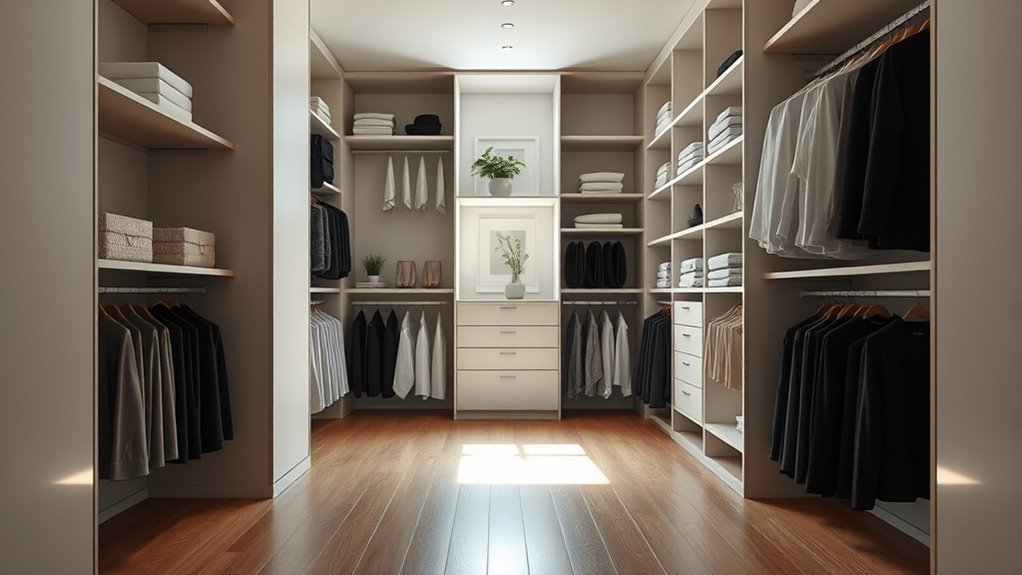
To create a functional closet, start by tackling those hidden spaces that often collect clutter.
Categorizing and prioritizing your items can help you maintain order and make it easier to find what you need.
Regularly evaluating your belongings guarantees your closet stays streamlined and organized.
Start With Hidden Spaces
While tackling the clutter in your home, starting with hidden spaces like closets and attics can make the process feel less overwhelming.
By focusing on these areas first, you can effectively manage items that often accumulate out of sight. Here are a few strategies to contemplate:
- Clear out unnecessary items that no longer serve a purpose.
- Create designated spaces for each category of belongings.
- Utilize storage solutions like bins or shelves for better organization.
- Regularly maintain your hidden spaces to prevent future clutter.
Decluttering hidden spaces improves functionality, making it easier to access your belongings and keeps your home organized. Additionally, implementing preventive maintenance for your appliances can help reduce the clutter caused by malfunctioning items or unused appliances.
Establishing order in these areas sets a solid foundation for a more streamlined living environment.
Categorize and Prioritize Items
When you categorize and prioritize items in your closet, you create a more functional space that simplifies your daily routines. Start by grouping similar items, like clothing, accessories, and shoes. Next, prioritize items you use most often by placing them at eye level or in easy-to-reach spots. Using clear bins or labeled containers enhances visibility, making it easier to find what you need. Additionally, just as Leave No Trace principles ensure the preservation of natural spaces during camping, adopting a mindful approach to decluttering can help maintain a serene environment in your closet.
Here's a quick visual representation:
| Category | Action |
|---|---|
| Clothing | Hang by type (e.g., shirts, pants) |
| Accessories | Use bins for easy access |
| Shoes | Store frequently worn pairs at front |
| Seasonal Items | Keep out-of-season items in the back |
| New Items | One-in, one-out policy for balance |
This method guarantees a clutter-free closet!
Maintain Regular Organization Habits
Maintaining regular organization habits is essential for keeping your closet functional and clutter-free. By adopting these simple strategies, you can guarantee your stuff stays manageable and organized:
- Declutter hidden areas: Regularly check shelves and bins for unwanted items.
- Seasonal reviews: Every few months, assess your closet and remove items you no longer need.
- Designate specific spots: Give each item a home to make finding things easy.
- Use clear storage solutions: Labeled bins or transparent containers enhance visibility and prevent clutter.
Implementing these habits not only reduces the accumulation of unnecessary stuff but also helps maintain a closet that reflects your current needs and preferences. Additionally, developing a growth mindset can further enhance your organizational skills, enabling you to embrace changes and challenges in maintaining an organized space.
The Joy of Surrounding Yourself With Cherished Items
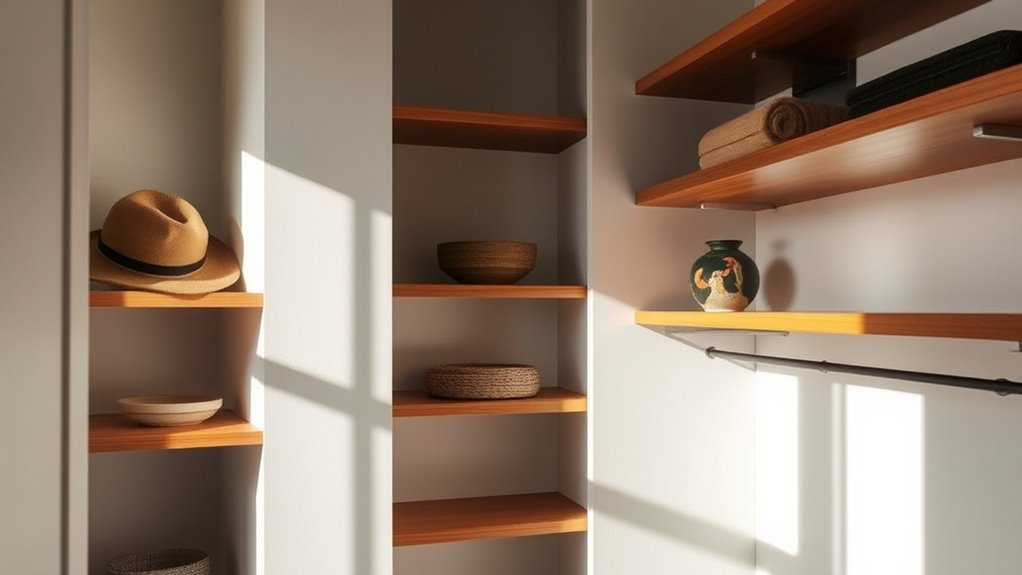
Surrounding yourself with cherished items transforms your space into a sanctuary of joy and meaning.
By focusing on possessions that evoke positive feelings, you create a personalized environment that reflects your values and memories. This intentional selection of cherished items fosters a sense of belonging and satisfaction, making your home truly yours.
When you declutter with an emphasis on what you love, you reduce stress and enhance functionality, ultimately leading to a more organized and serene atmosphere.
Prioritizing these beloved possessions not only promotes mindfulness in consumption but also encourages a calming daily life. Embracing the joy of surrounding yourself with cherished items elevates your living space and deepens your emotional connection to it. Additionally, creating an environment filled with heartfelt expressions of love can significantly enhance your overall well-being.
Overcoming Common Decluttering Challenges
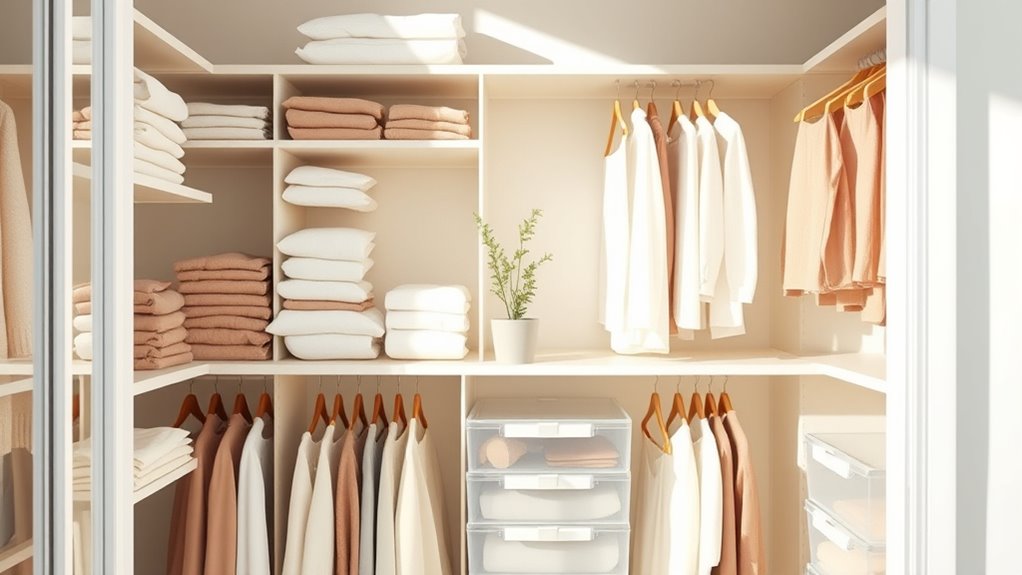
Although decluttering can feel overwhelming, tackling common challenges doesn't have to be an intimidating task. By implementing effective strategies, you can make your closet more functional and organized.
Here are some tips for overcoming common decluttering challenges:
- Start with hidden areas, like the back of the closet.
- Address clutter on countertops to streamline your decluttering process.
- Focus on intentionality by keeping only cherished items.
- Embrace a minimalist mindset to reduce tolerance for clutter.
The Benefits of a Peaceful and Calm Living Space

Creating a peaceful and calm living space greatly enhances your overall quality of life. Minimalism reduces clutter, lowering stress and boosting happiness. A functional living space, especially in closets, makes your daily routine more efficient. Decluttering saves money and fosters mindfulness, while a serene home environment helps you focus on what truly matters.
| Benefit | Description | Impact |
|---|---|---|
| Reduced Stress | Clutter-free spaces lower anxiety levels | Improved well-being |
| Enhanced Efficiency | Easy access to items saves time | Streamlined routines |
| Increased Mindfulness | Intentional consumption promotes clarity | Greater awareness |
| Boosted Happiness | A tidy environment fosters joy | Elevated mood |
Embrace minimalism; it's the key to a tranquil living space.
Small Steps Toward Achieving a Minimalist Lifestyle

To achieve a minimalist lifestyle, start with small, manageable steps that make a big difference in your space.
Focus on the less visible areas like closets and attics where clutter hides.
Here are some effective strategies for you:
- Limit your clothing items to a specific number.
- Regularly evaluate items and remove those no longer cherished.
- Establish designated places for everything in your closet.
- Tackle one thing at a time to avoid overwhelm.
Frequently Asked Questions
What Is the 90-90 Rule for Minimalism?
The 90-90 Rule for minimalism helps you assess your belongings effectively.
If you haven't used an item in the last 90 days and don't plan on using it in the next 90 days, it's time to contemplate letting it go.
This rule encourages you to focus on practicality and emotional value, making it easier to declutter and create a living space that truly reflects your priorities and enhances your daily life.
What Is the 80/20 Rule in Minimalism?
Imagine a world where 80% of your clutter vanishes with just a little effort!
That's the magic of the 80/20 Rule in minimalism. You focus on the 20% of items that spark joy or get daily use, letting go of the rest.
By honing in on what truly matters, you streamline your space and life, reducing chaos.
You'll feel lighter, more organized, and ready to embrace the freedom of a clutter-free existence!
Where Do Minimalists Keep Their Stuff?
Minimalists typically keep their belongings in designated spaces that reflect their values.
You'll find items organized in a way that emphasizes accessibility and functionality. Each piece you own has a specific place, reducing clutter considerably.
Often, you'll notice that minimalists prefer quality over quantity, holding onto only what truly serves a purpose or brings joy.
Regular decluttering keeps their spaces streamlined, making it easy to maintain order in their homes.
Is Minimalism Good for ADHD?
Yes, minimalism can be great for ADHD. By reducing visual distractions, you can improve your focus and lessen overwhelm.
When you embrace minimalism, you intentionally keep only what's meaningful or useful, which helps manage clutter. This approach creates organized spaces that promote clarity and calmness.
Plus, having designated spots for your belongings makes it easier to find what you need, saving you time and reducing frustration in your daily life.
Conclusion
As you embrace minimalism, think of your closet as a garden—tending to it with care allows your cherished items to flourish. By cultivating intentionality and letting go of the excess, you not only create a serene space but also free your mind from the chaos of clutter. Each small step you take is like planting a seed, nurturing a lifestyle that blooms with clarity and peace. So, take a breath, and watch your life transform into a tranquil sanctuary.


